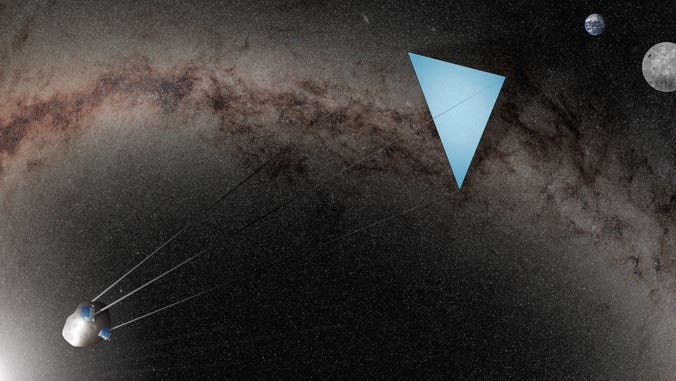Solar ‘umbrellas’ and asteroids could be the solution to global climate change
This revolutionary approach has the potential to dramatically alter the trajectory of climate change within our lifetimes.

[Aug. 5, 2023: Staff Writer, The Brighter Side of News]
One of the simplest approaches to reducing the global temperature is to shade the Earth from a fraction of the Sun’s light. (CREDIT: Brooks Bays/UH Institute for Astronomy)
In an era where our planet is facing the adverse impacts of global warming at an alarming rate, innovative solutions are required more than ever. István Szapudi, a renowned astronomer from the University of Hawaiʻi Institute for Astronomy, is challenging the frontiers of current scientific approaches with a concept that might sound straight out of a sci-fi plot – employing a solar shield to regulate sunlight hitting the Earth, anchored in place with an asteroid. If realized, this revolutionary approach has the potential to dramatically alter the trajectory of climate change within our lifetimes.
The study, aptly titled "Solar radiation management with a tethered sun shield," found its home in the esteemed journal, Proceedings of the National Academy of Sciences, sparking discussions and hope within the scientific community.
A Ray of Sunlight Too Many
The sun has been Earth's primary energy source since time immemorial, but with the present climate conundrum, even its benevolent light needs filtering. The mechanism is akin to a simple concept - shade.
Shielding the Earth from a small fraction of the Sun's rays can decrease global temperatures. But here's where it gets complicated: a massive shield, light yet strong enough to withstand gravitational and solar forces, requires materials that, given current resources, are excessively costly.
Related Stories
Szapudi's groundbreaking proposition centers around two critical innovations. First, he suggests utilizing a tethered counterweight to decrease the shield's mass, making it over 100 times lighter than what was previously thought possible. Second, rather than launching this counterweight from Earth, an astronomically expensive and cumbersome process, he proposes capturing an asteroid for the job.
Drawing parallels from daily life, Szapudi shares, “In Hawaiʻi, many use an umbrella to block the sunlight as they walk about during the day. I was thinking, could we do the same for Earth and thereby mitigate the impending catastrophe of climate change?”
Rethinking Radiation Management
At the heart of this proposal lies a number: 1.7%. This is the estimated solar radiation reduction needed to thwart the looming danger of a catastrophic rise in global temperatures. Szapudi's calculations showed that a tethered counterbalance can achieve this goal with a total weight of just 3.5 million tons - a far cry from earlier projections.
Artist’s rendition of the proposed solar shield tethered to an asteroid as a counterweight. (CREDIT: Brooks Bays/UH Institute for Astronomy)
The real ingenuity here is in the breakdown of this mass. Only 1% (roughly 35,000 tons) would represent the actual shield, necessitating a launch from Earth. With advancements in material science, particularly in lightweight materials, this number could shrink further. Meanwhile, the bulk of the counterweight, a whopping 99%, could come from asteroids or lunar dust.
Given that our most potent rockets can ferry only about 50 tons to low Earth orbit, this design's feasibility is striking. Szapudi’s strategy not only seems achievable with current technological capabilities but also offers a more cost-effective and quicker deployment solution compared to prior designs. Nonetheless, developing a sturdy yet lightweight tether, perhaps made of graphene, is pivotal to this plan's success.
For more science stories check out our New Discoveries section at The Brighter Side of News.
Note: Materials provided above by the The Brighter Side of News. Content may be edited for style and length.
Like these kind of feel good stories? Get the Brighter Side of News' newsletter.
Joseph Shavit
Head Science News Writer | Communicating Innovation & Discovery
Based in Los Angeles, Joseph Shavit is an accomplished science journalist, head science news writer and co-founder at The Brighter Side of News, where he translates cutting-edge discoveries into compelling stories for a broad audience. With a strong background spanning science, business, product management, media leadership, and entrepreneurship, Joseph brings a unique perspective to science communication. His expertise allows him to uncover the intersection of technological advancements and market potential, shedding light on how groundbreaking research evolves into transformative products and industries.



